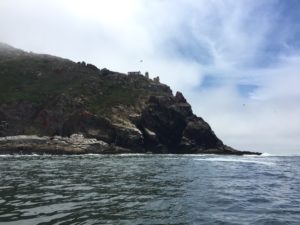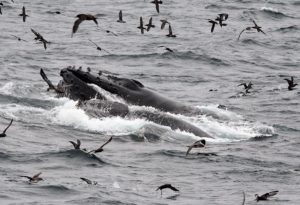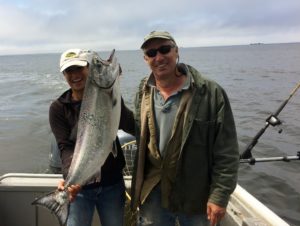by Tom Baty, Fisherman, Conservationist, PLC Board Member

Seven miles southeast of Point Reyes Lighthouse the ocean is in a rolling boil. Below the calm surface are acre upon acre of krill, the small shrimp that is a cornerstone species in this part of the Pacific Ocean. All around the boat dozens of whales surface, dive and feed through the clouds of reddish-orange shrimp–today mostly humpbacks and blues with an occasional minke and fin whale in the mix. Murres, shearwaters, and auklets dive and feed on the same food as the whales. On the surface countless gulls take advantage of the krill being pushed to the surface by the whales and diving birds.

Below the surface an unknown number of Chinook salmon swirl and feed through the same bait. Fishing vessels troll tight configurations above, now and then hooking and landing one of these magnificent fish. We circle our boat through the morning, catching our limits and marveling at the spectacle. My fishing companions and I know this experience is a gift. It seems difficult to gage whether having an 18 pound salmon on the line or an 80 foot blue whale surface right beside us is more exhilarating. Different joys, both magical.

This scene on the ocean is less than 20 miles from the greater San Francisco urban area. It is completely within the Gulf of the Farallones National Marine Sanctuary. This sanctuary and the adjacent Cordell Banks National Marine Sanctuary are where I have spent countless days for the past four decades, chasing salmon, crab, halibut, and albacore. These National Marine Sanctuaries provide a layer of protection to this amazing ecosystem, limiting certain development and outright banning undersea mining and oil and gas extraction. The Sanctuaries also provide ongoing research to better understand, manage, and protect species and their critical habitats. They recognize the values of local fisheries and their importance in vibrant coastal communities.
The Gulf of the Farallones and Cordell Banks National Marine Sanctuaries are currently at risk. The Secretary of the Commerce has begun a “review” of these and other Marine Sanctuaries and could reduce these sanctuaries in size and/or protective regulatory authority. They, like so many of our other public lands and water agencies, are also being compromised by acute budget cuts and regulatory rollbacks.
Now is the time to speak up and defend our Marine Sanctuaries.
You must comment by August 14: https://www.regulations.gov/document?D=NOAA-NOS-2017-0066-0001